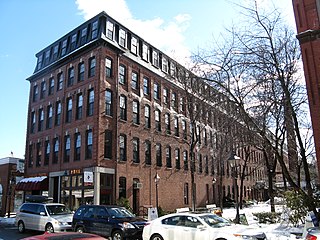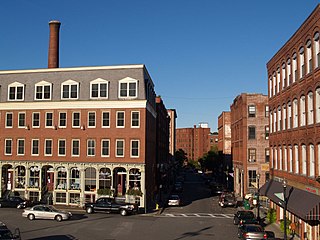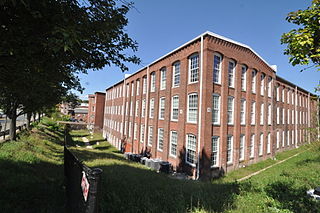
The Curtis Building is a historic commercial building in Brockton, Massachusetts, US. The three-story brick building was built in 1870, and is a fine local example of Romanesque styling. It features panel brick pilasters on the corners, and panel brick decoration in the cornices. Its window bays, consist of paired windows separated by brick piers; the third floor windows are set in double round-arch openings.

The Franklin Block is a historic commercial building in Brockton, Massachusetts. The three-story brick Romanesque Revival-style building was built in 1888. Its construction marked the high point in the economic recovery of the city's Campello neighborhood, which had been devastated by fire in 1853, and is one of two 19th-century buildings in the area. The building was listed on the National Register of Historic Places in 1989.

The F. A. Whitney Carriage Company Complex Historic District encompasses a major 19th-century industrial complex off 124 Water Street in Leominster, Massachusetts. The complex is one of the best-preserved in the city, and was developed by of its most successful businesses of the late 19th and early 20th centuries. The F. A. Whitney Company, founded in 1858, manufactured baby carriages and related products, and operated here from 1862 to 1952, and was one of the city's major employers. The oldest surviving buildings of its manufacturing complex date to 1872. The district was listed on the National Register of Historic Places in 1988. Most of the complex has been converted into residential use.

The E. P. Dodge Building is a historic building at 19-23 Pleasant Street in Newburyport, Massachusetts. The Italianate five story brick building was built in 1873 by Elisha P. Dodge, a shoemaker, for use as a factory. When first built it was only four stories, but when Dodge enlarged the premises in 1880, the mansard section was added on top. The building remained in use as a shoe factory until the 1930s, and is now used for commercial and light industrial purposes.

The Munroe Street Historic District encompasses some of the few commercial buildings to survive in downtown Lynn, Massachusetts from the mid 19th century. The district includes properties on Munroe Street between Market and Washington Streets, which was spared by the 1889 fire that destroyed much of Lynn's downtown area. It was listed on the National Register of Historic Places in 1996.

The Lynn Realty Company Building No. 2 is a historic commercial building at 672-680 Washington Street in Lynn, Massachusetts. A long rectangular eight story brick building, it was built in 1902 to a design by local architect Henry Warren Rogers. The building is three window bays wide and seventeen long. Although it originally formally fronted on Washington Street, it extends on its long axis for most of a city block along Farrar Street. The original Washington Street entrance has been filled in, and the present entrance is now at what was the rear of the building, the southeast side, where there is a metal awning leading to a modern glass door. Windows on the street-facing sides are paired, with granite sills and header arches of a lighter-colored brick than the main body of the building. Brick pilasters rise between these paired windows the full height of the building, to a modestly-corbelled cornice.

The Intervale Factory is a historic Late-Victorian factory building at 402 River Street in Haverhill, Massachusetts. Built in 1889, it is one of Haverhill's better-preserved shoe factory buildings. Now converted to apartments, it was listed on the National Register of Historic Places in 1988.

The Washington Street Shoe District of Haverhill, Massachusetts encompasses a two block section of Washington and Wingate Streets, between Railroad Square and Essex Street, in which there were more than 60 shoe factories established in the late 19th century. Buildings in the district are predominantly brick with Italianate styling, and are of a modest scale, unlike later shoe factories which resembled textile mills in size and style. The district was listed on the National Register of Historic Places in 1976.

The Item Building is a historic commercial building at 26 Albion Street in Wakefield, Massachusetts. Built in 1912, the single-story brick building serves as the headquarters of The Wakefield Daily Item, Wakefield's main community newspaper, and is a well-kept example of early 20th century commercial architecture.

The Central Mills Historic District encompasses a historic mill complex on the Quinebaug River in central Southbridge, Massachusetts. Located at the corner of Foster and North Streets, the site consists of three brick buildings, the oldest of which has portions dating to 1837. Despite being extensively rebuilt in the early 20th century, the complex has an appearance that is more typical of 19th century mills.

The Centre Village Historic District encompasses the historic central business district of Southbridge, Massachusetts. The district includes properties on Main Street, roughly between Elm and Goddard Streets. The central area represents a fairly well preserved Late Victorian commercial center. It was added to the National Register of Historic Places in 1979.

The Beverly Depot–Odell Park Historic District encompasses a commercial and industrial area of Beverly, Massachusetts that was developed to its height in the late 19th and early 20th centuries. A central theme of the district relates to Beverly's transportation history with several railroad-related buildings, a carriage manufactory and early automobile factory. The district, listed on the National Register of Historic Places in 2014, include two buildings previously listed: the Beverly Depot, built 1896, and the main post office, built 1910.

The Nashawannuck Mills Historic District of Easthampton, Massachusetts encompasses a 19th-century industrial complex on Cottage Street in the heart of the town. Most of the connected series of brick buildings were built between about 1848 and 1870, although the facilities were used for industrial purposes until 1970. The oldest building erected was by Samuel Williston for a button factory. Powered by a dam that impounded Bound Brook, the facility expanded in both size and function, eventually becoming a major producer of elastic fabrics for goods such as suspenders and webbing. The industrial works were the major economic engine in Easthampton into the 20th century. The district was listed on the National Register of Historic Places in 2015.

The Hancock Apartment Building. also known as the Schaffer Apartments, is a historic mixed-used retail and residential apartment building at 116-118 Hancock Street and 130 Tyler Street on the east side of Springfield, Massachusetts. Built in 1912, it is good local example of an early 20th-century Classical Revival apartment house, built as the city's outer neighborhoods grew as streetcar suburbs. The building was listed on the National Register of Historic Places in 2015.

The Francis Street–Fenwood Road Historic District encompasses a small but cohesive early 20th-century residential area and streetcar suburb in the Longwood area of Boston, Massachusetts. Bounded by Huntington Avenue, Francis Street, Vining Avenue, Fenwood Road, and St. Albans Road, it includes a collection of two and three-family houses, as well as two apartment houses, a school, and one commercial building, all of which predate the large medical complexes that dominate the Longwood area. The district was listed on the National Register of Historic Places in 2016.

The M.M. Rhodes and Sons Company is a historical button factory complex at 12 Porter Street in Taunton, Massachusetts. Established in 1861 and operational until 2014, it was one of the first successful papier-mâché shoe button manufacturers in the United States. Its surviving factory complex is one of the last early 20th-century complexes left on Taunton's once heavily industrialized south side. The complex was listed on the National Register of Historic Places in 2016.

The Moran Square Historic District is a historic district encompassing an area of late 19th and early 20th-century industrial, commercial, and residential development in Fitchburg, Massachusetts. Centered on the triangular junction of East Main Street with Lunenburg and Summer Streets, this area developed as a secondary node apart from the city's main commercial district, in an area were several industrial plants were undergoing significant growth. The district was listed on the National Register of Historic Places in 2018.

The Emerson Shoe Company is a historic industrial property located at Maple and Plain Streets in Rockland, Massachusetts. Built about 1891 and repeatedly enlarged, it is the largest wood-frame structure in Rockland, and was home to one of its largest employers in the early 20th century. Now converted to residential use, the factory complex was listed on the National Register of Historic Places in 2018.

The Leonard, Shaw & Dean Shoe Factory is a historic industrial property located at Rice and Peirce Streets in Middleborough, Massachusetts. Built in 1896 and repeatedly enlarged before 1911, it was home to one of the town's major employers. Now converted to residential use, the factory complex was listed on the National Register of Historic Places in 2018.

The New England Telephone and Telegraph Engineering Office is a historic commercial building at 47 Pleasant Street in Brockton, Massachusetts. Built in 1923, this Classical Revival building house support services for the main exchange of the local telephone company until about 1950, and has seen other commercial uses since then. It was listed on National Register of Historic Places in 2019 for its architecture, and the role the telephone company played in Brockton's 20th-century growth. It has more recently been converted to residential use.























